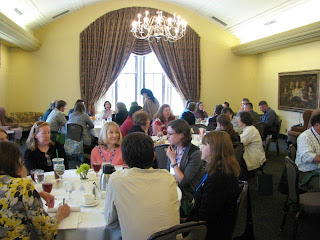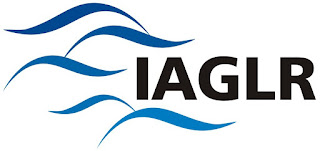The overall message he shared with the attendees was that even common plants associated with water gardens can quickly become “aquatic invaders” under the right conditions. Aquatic invaders are plants and animals that cause ecologic and economic harm once established in public waterways, and removing them can be very expensive and often impossible. One way that aquatic invaders are introduced or spread into public waters is through the intentional or unintentional release of species from water gardens and koi ponds.
Category:
IISG asks water gardeners’ help in preventing the spread of invasive species
July 12th, 2013 by Irene MilesTeachers and scientists give high marks to IISG’s Educator Day at IAGLR 2013
July 10th, 2013 by Irene MilesFrom Robin Goettel, IISG associate director for education:
Scientists and teachers had a unique opportunity to interact, network, and connect research with education during The Center for Great Lakes Literacy’s Educator Day at last month’s IAGLR 2013 conference in West Lafayette, Indiana. Among the many goals of the IISG-coordinated session, providing opportunities for teachers to share their science education needs with researchers and identifying ways to incorporate the latest Great Lakes research into their lesson plans were high priorities.
The exchange of ideas was not only productive, but was a welcome and highly valued experience for all of the participants. The feedback received from both researchers and educators was outstanding, and offered a number of suggestions to guide another session like this in the future.
Said one teacher of the event, “I was impressed! My experience with IAGLR exceeded my expectations. I was hoping to simply gather more information to ‘grow’ my Great Lakes curriculum. However, I was able to network with other teachers and scientists which I found so much more valuable than walking away with a stack of Great Lakes lesson plans.”
Another educator was grateful for the opportunity to meet and talk to working researchers. “I am very thankful for the chance to interact with professionals in the field. Not only does attending scientific conferences refresh learned concepts, but allows for new learning, insight, and expansion of awareness. It also provided fresh ideas for project-based learning and the opportunity to network with potential collaborators.”
The participating scientists were also glad to brainstorm ways that their work could be incorporated into classroom lessons.
“I always enjoy talking with teachers who are ‘in the trenches’ with younger students. They are faced with a different set of challenges (and opportunities) than we have at the college level. It was nice to hear that there are current efforts to better integrate math and science. It was also interesting to hear what teachers introduce in their classrooms to motivate and engage students in STEM areas.”
Teachers from Great Lakes states begin a week of hands-on research on Lake Ontario
July 8th, 2013 by Irene MilesIn the news: Cool water forecast for some 4th of July swims
July 3rd, 2013 by Irene Miles“In contrast to air temperatures forecast in the 80s, Lake Michigan water won’t warm up in time for the Thursday holiday, according to the National Weather Service office in Grand Rapids.
Great Lakes video informs Congressional legislation
July 2nd, 2013 by Irene Miles In addition to reauthorizing the Great Lakes Legacy Act, which provides support for communities to clean up waterways that are designated Areas of Concern (AOC) the United States and Canada, the new legislation would continue funding the Great Lakes Restoration Initiative and the EPA Great Lakes National Program Office.
In addition to reauthorizing the Great Lakes Legacy Act, which provides support for communities to clean up waterways that are designated Areas of Concern (AOC) the United States and Canada, the new legislation would continue funding the Great Lakes Restoration Initiative and the EPA Great Lakes National Program Office.
Learn more about the Great Lakes Legacy Act at the EPA’s GLLA webpage.
More than just fish on the list of aquatic invasive species to watch out for
June 25th, 2013 by Irene MilesAquatic invaders come in a number of shapes, sizes, and varieties, and aren’t limited to mussels or fish. In addition to our “Be A Hero – Transport Zero” campaign asking boaters and water users to be on the lookout for invasive species, IISG has helped fund “Hydrilla Hunt!,” a program to keep this invasive plant from overtaking Illinois’ waters.
 Hydrilla verticillata, commonly known as “hydrilla,” is an aquatic invasive “superweed” – a non-native plant that can grow quickly in waterways and cause serious environmental and economic damages. But before this species takes over, Illinois partners are asking water lovers for their help in preventing hydrilla’s spread.
Hydrilla verticillata, commonly known as “hydrilla,” is an aquatic invasive “superweed” – a non-native plant that can grow quickly in waterways and cause serious environmental and economic damages. But before this species takes over, Illinois partners are asking water lovers for their help in preventing hydrilla’s spread. “Recognized as one of the world’s worst weeds, hydrilla can grow an inch per day and form dense mats of vegetation at the water surface. Within the past few years, hydrilla has been discovered in Wisconsin and Indiana and it is expected to arrive in Illinois very soon. Our desirable native aquatic plants, sport fishing, native wildlife, waterfront property values, and recreational uses might all be seriously impacted.‘Early detection of hydrilla could save Illinois millions of dollars in control costs,’ noted Cathy McGlynn, coordinator for the Northeast Illinois Invasive Plant Partnership (NIIPP). ‘Experience from other states shows that once a waterway becomes infested with hydrilla, it’s nearly impossible to control. Our hope in Illinois is to identify the plant at a very early stage when populations are still small enough to eradicate and manage,’ added McGlynn.”
Find out more about the program and hydrilla as an invasive species by visiting the “Hydrilla Hunt!” website.
*Photo courtesy of the Indiana Cooperative Agricultural Pest Survey Program
New campaign asks water lovers to help stop aquatic invaders
June 14th, 2013 by Irene Miles From boaters and kayakers to waterfowl hunters, scuba divers, sea plane operators, and more, everyone can help prevent invasive species from taking over their favorite waterways with these three actions.
From boaters and kayakers to waterfowl hunters, scuba divers, sea plane operators, and more, everyone can help prevent invasive species from taking over their favorite waterways with these three actions. IISG interns relate their IAGLR 2013 experiences
June 10th, 2013 by Irene MilesThree of IISG’s interns were among the hundreds of scientists, researchers, educators, and more in attendance at last week’s IAGLR 2013 conference. Each of them wrote in to tell us more about their experiences at the conference, and some interesting things they took away from the sessions.
Blue Island stormwater program gets major recognition
June 7th, 2013 by Irene MilesWith such a rainy and flood-producing spring, one’s thoughts may just turn to something practical–rain barrels. Let’s look back on last fall’s rain barrel project in Blue Island.
Illinois-Indiana Sea Grant was one of five lead partners in the “Blue Island, Blue Water” community-based program designed to reduce stormwater overflows and flooding issues in the Chicago suburb. Over the course of the project, more than 140 volunteers installed rain barrels at 33 different residential locations and three institutional buildings. Additionally, more than 1000 plants and nearly 100 trees were planted to help improve water management and beautify neighborhoods at the same time.
“Keeping water out of sewers also reduces run-off, which in turn reduces pollution in the Cal-Sag Channel. The Cal-Sag is an increasingly popular destination for Chicagoland kayakers and nature lovers, but the channel requires a strong commitment to water quality, since it runs through densely built residential and industrial areas that are potential sources of pollution. Thus, stormwater management in Blue Island represents a key effort in which ‘local, state and county governments work together to really make an impact in our neighborhoods,’ according to (zoning administrator and director of special projects Jason) Berry.”
The “Blue Island, Blue Water” project was also chosen as a 2012 Millenium Reserve Model Project. The project’s inclusion also makes it part of the President’s “America’s Great Outdoors Initiative,” which helps align federal efforts and funds with conservation and recreation projects on the local level where they can make real and immediate impacts. You can learn more about the project at the links above and at this ABC 7 news report from earlier this year. And read more about the Millennium Reserve’s place within the initiative here.
Recent News
- Tomas Höök signing off as Illinois-Indiana Sea Grant director this summer
- Illinois-Indiana Sea Grant welcomes Stuart Carlton as the program’s new director
- Four Illinois and Indiana educators will set sail on Lake Michigan aboard EPA’s research ship
- Join IISG as a new pollution prevention outreach assistant
- Beach season means it’s time for lifesaving Lake Michigan water safety resources
IISG Instagram
📢 Show Your Support for Sea Grant! 📢
Continued federal funding for Sea Grant in FY26 is crucial, and we need your help to demonstrate the nationwide support for these essential programs.
🖊️ Sign the letter urging Congress to continue funding Illinois-Indiana Sea Grant and all 34 state Sea Grant programs:
🔗 https://forms.gle/7sPGHGyh8j8a7vfGA or link in bio

Exciting news! The call for sessions for the 2026 Emerging Contaminants in the Environment Conference has been extended!
We are excited to offer the opportunity to propose a speaker or panel session during the 2026 Emerging Contaminants in the Environment Conference April 28-29. The conference will feature traditional 15-minute presentations and a poster session on the latest in emerging contaminant research, policies, and outreach in the soil, water, and air.
The deadline to propose a session is September 30, 2025.
Learn more at go.illinois.edu/ecec or the link in bio

Stay safe and have fun this Fourth of July with these 5 water safety tips! Click the link in bio to learn more ways to keep yourself and others safe as you enjoy the Lake Michigan beaches this holiday.

Four science educators from Illinois and Indiana have been selected for the 2025 Shipboard Science Immersion on Lake Michigan July 7-13. The educators will spend a full week alongside researchers aboard the EPA research vessel Lake Guardian. Afterwards, they will bring Great Lakes science back to their classroom.
Learn more and meet the four incredible teachers representing Illinois and Indiana at the link in bio.

Categories
- Aquaculture
- Aquatic Invasive Species
- Buoys
- Climate Ready Communities
- Director's Blog
- Education
- Featured
- Fellowships
- Fisheries
- Funded Research
- Funding
- Great Lakes Cleanup
- Great Lakes Data
- Healthy Waters
- Internships
- Jobs
- K-12 Education
- News
- Photos
- Program
- Recreation & Tourism
- Resources
- Sea Grant Scholars
- Stormwater & Green Infrastructure
- Sustainable Community Planning
- The Helm
- Uncategorized
- Video
- Water Resource Economics






